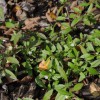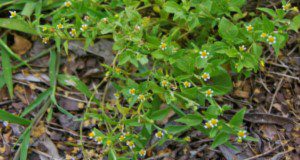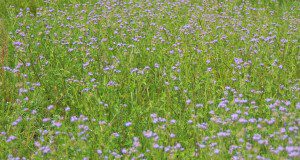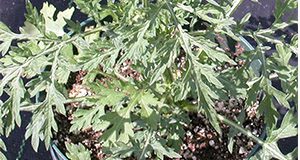Galinsoga (Galinsoga quadriradiata) is an erect (upright), herbaceous, short-lived warm-season annual weed in Florida landscapes, container nurseries, and other agricultural production systems. In nurseries and landscapes, galinsoga can be a troublesome weed, but it has been utilized by some cultures for food or medicinal purposes. This new 5-page article is written for green-industry professionals and others to aid in the identification and management of galinsoga in and around ornamental plants. Written by Thomas Smith, Chris Marble, Shawn Steed, and Nathan Boyd, and published by the UF/IFAS Environmental Horticulture Department.
https://edis.ifas.ufl.edu/ep593
Tag: Asteraceae
Biology and Management of Praxelis (Praxelis clematidea) in Ornamental Crop Production
Praxelis is a newly emerging weed species in Florida, one that Plant Protection and Quarantine (PPQ) is considering adding to the federal noxious weed list. The plant can be easily misidentified and confused with Ageratum houstonianum (bluemink) and Conoclinium coelestinum (blue mistflower) as well as several other species that have similar flower characteristics. This new 5-page article is written for green industry professionals and others to aid in the identification and management of praxelis in and around ornamental plants. Written by Yuvraj Khamare, Chris Marble, Shawn Steed, and Nathan Boyd, and published by the UF/IFAS Environmental Horticulture Department.
https://edis.ifas.ufl.edu/ep585
Biology and Management of Spanish Needles (Bidens spp.) in Ornamental Crop Production
All eight species of Bidens in Florida are commonly referred to as Spanish needles or beggar-ticks. This document focuses on Bidens alba and B. pilosa, which are common weeds in container nurseries and landscapes in Florida. This 6-page EDIS publication, written by Yuvraj Khamare, Chris Marble, Shawn Steed, and Nathan Boyd and published by the UF/IFAS Environmental Horticulture Department, is designed for landowners, gardeners, horticulturalists, and consumers hoping to learn more about Spanish needle classification and management.
http://edis.ifas.ufl.edu/ep572
Biology and Management of Ragweed Parthenium (Parthenium hysterophorous L.) in Ornamental Crop Production
This six-page fact sheet provides an overview of Ragweed Parthenium, Parthenium hysterophorous L, including a species description and information on how to manage ragweed parthenium culturally, physically, and chemically. Written by Debalina Saha, Chris Marble, Robert H. Stamps, and Shawn Steed and published by the Environmental Horticulture Department.
http://edis.ifas.ufl.edu/ep531
Biology and Management of Eclipta (Eclipta prostrata) in Ornamental Crop Production
 Eclipta grows aggressively in containers and can outcompete nursery crops for water, nutrients, and light. Plants flower in as little as five weeks after germination and produce thousands of seeds over the course of a growing season, and stem fragments left on the soil or media surface following hand-weeding or cultivation can root and reproduce vegetatively. This 4-page fact sheet describes the plant, its biology, and recommendations for physical, cultural, and chemical control. Written by Chris Marble, Shawn Steed, and Nathan S. Boyd, and published by the UF Department of Environmental Horticulture, January 2015. (Photo: Annette Chandler, UF/IFAS)
Eclipta grows aggressively in containers and can outcompete nursery crops for water, nutrients, and light. Plants flower in as little as five weeks after germination and produce thousands of seeds over the course of a growing season, and stem fragments left on the soil or media surface following hand-weeding or cultivation can root and reproduce vegetatively. This 4-page fact sheet describes the plant, its biology, and recommendations for physical, cultural, and chemical control. Written by Chris Marble, Shawn Steed, and Nathan S. Boyd, and published by the UF Department of Environmental Horticulture, January 2015. (Photo: Annette Chandler, UF/IFAS)
http://edis.ifas.ufl.edu/ep512
Identification, Impacts, and Control of Ragweed Parthenium (Parthenium hysterophorus L.) (ENH1187/EP448)
 One of the worlds most invasive weeds, this member of the Asteraceae family is a problem in Africa, Australia, India, and is increasingly a problem in Florida. Learn more in this 10-page fact sheet was written by Robert H. Stamps, and published by the UF Department of Environmental Horticulture, December 2011.
One of the worlds most invasive weeds, this member of the Asteraceae family is a problem in Africa, Australia, India, and is increasingly a problem in Florida. Learn more in this 10-page fact sheet was written by Robert H. Stamps, and published by the UF Department of Environmental Horticulture, December 2011.
http://edis.ifas.ufl.edu/ep448
Dogfennel (Eupatorium capillifolium): Biology and Control (SSAGR224/AG233)
 Dogfennel is currently the number one most commonly occurring pasture weed in Florida. Many people think it is only unsightly, but it causes significant bahiagrass yield loss and can cause dehydration when ingested by cattle. This 3-page fact sheet was written by B. A. Sellers and J. A. Ferrell and published by the UF Department of Agronomy, September 2011.
Dogfennel is currently the number one most commonly occurring pasture weed in Florida. Many people think it is only unsightly, but it causes significant bahiagrass yield loss and can cause dehydration when ingested by cattle. This 3-page fact sheet was written by B. A. Sellers and J. A. Ferrell and published by the UF Department of Agronomy, September 2011.
http://edis.ifas.ufl.edu/ag233



